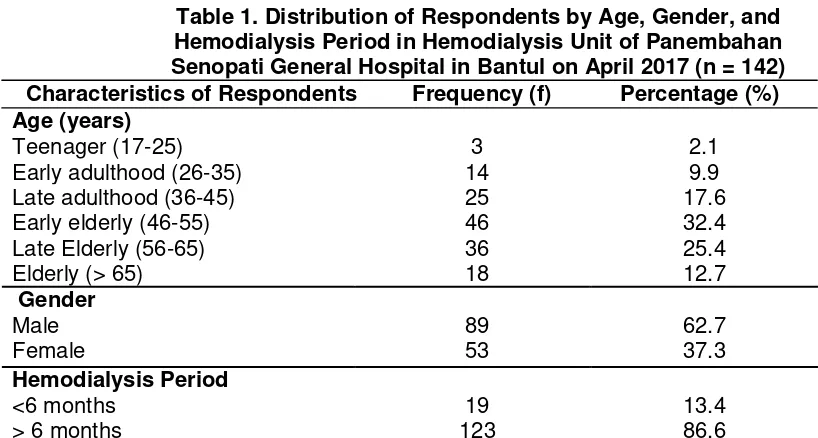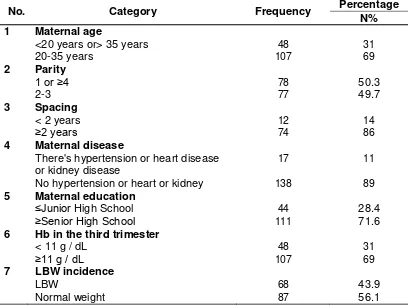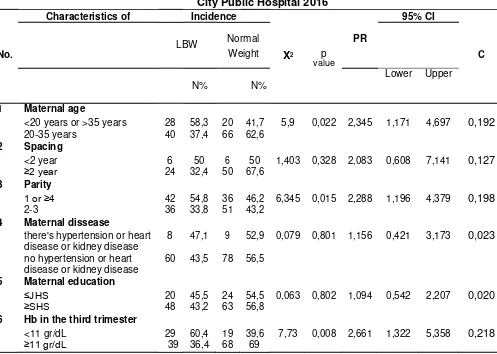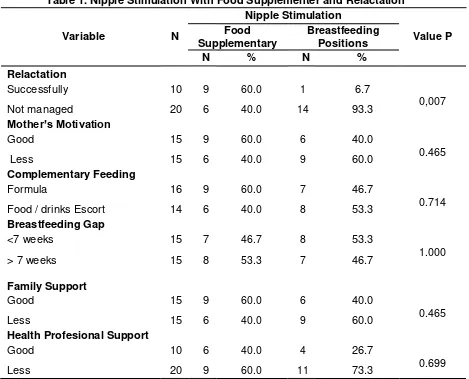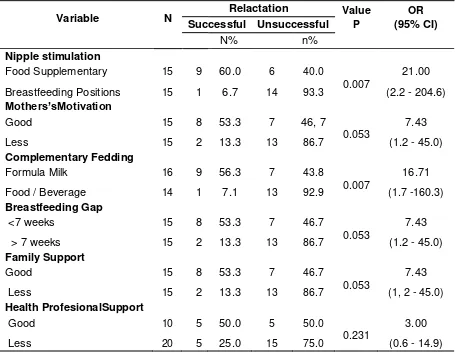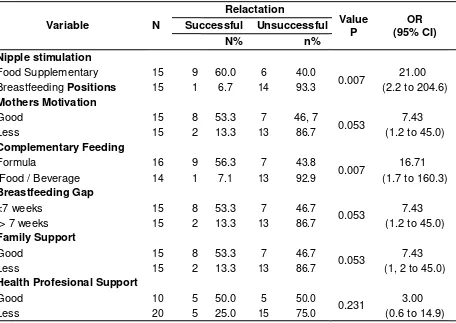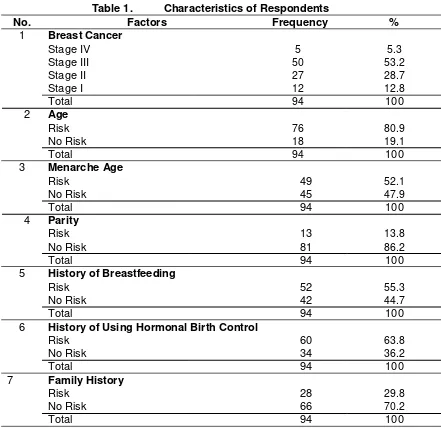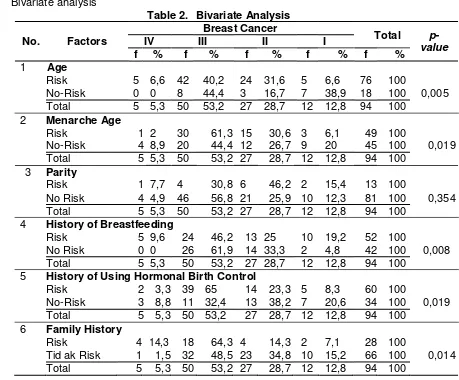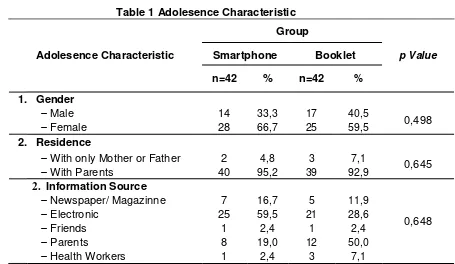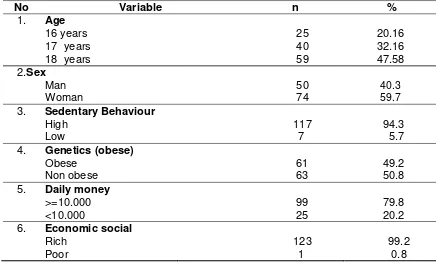PROCEEDING BOOK
THE 4
thINTERNATIONAL CONFERENCE
ON HEALTH SCIENCE 2017
“The Optimalization of Adolescent Health in The
Era of SDGs”
INNA GARUDA HOTEL YOGYAKARTA,
INDONESIA
November 5
th, 2017
HEALTH POLYTECHNIC OF HEALTH MINISTRY YOGYAKARTA Jl. Tata Bumi No.3, Banyuraden, Gamping,
PROCEEDING BOOK
THE 4
thINTERNATIONAL CONFERENCE
ON HEALTH SCIENCE 2017
“The Optimalization of Adolescent Health in The Era of
SDGs”
INNA GARUDA HOTEL YOGYAKARTA,
INDONESIA
November 5
th, 2017
Copyright is protected by Copyright Law year
1987
No part of publication may be reproduced in any methods without
written permission of the publisher
ISBN : 978-602-73585-1-5
Published by
Health Polytechnic of Ministry of Health in
Yogyakarta 2017
Proceeding of
The 4th International Conference on Health Science 2017 “The Optimalization of Adolescent Health in The Era of SDGs”
Printed in Yogyakarta
November 2017
Editorial Board for Proceeding Chief:
Sabar Santoso, S.Pd.,APP.,M.Kes
Members:
Apriyatni Condro Ekarini, S.ST.,M.Kes Andika Trisurini, S.Pd
Ayu Triani, S.T. Dina Fadhilah, S.Tr
Reviewer:
Sammy Onyapidi Barasa, BSN,MPH (Kenya Medical Training College Chuka Campus)
Dr. Shefaly Shorey (National University of Singapore)
Th. Ninuk Sri Hartini, Ph.D
(Health Polytechnic of Health Ministry Yogyakarta, Indonesia) Nugraheni Tri Lestari, SKM, MPH
(Health Polytechnic of Health Ministry Yogyakarta, Indonesia) Dr. Yuni Kusmiyati, SST.,M.PH
(Health Polytechnic of Health Ministry Yogyakarta, Indonesia) Dr. Jenita DT Donsu, SKM.,M.Si
(Health Polytechnic of Health Ministry Yogyakarta, Indonesia) Dr. Catur Budi Susilo, S.Pd.,S.Kp.,M.Kes
(Health Polytechnic of Health Ministry Yogyakarta, Indonesia) Muji Rahayu, S.Si.,Apt.,M.Sc
(Health Polytechnic of Health Ministry Yogyakarta, Indonesia)
Editors:
Sabar Santoso, S.Pd.,APP.,M.Kes Dr. drg. Wiworo Haryani,M.Kes Dr. Ir. I Made Alit Gunawan, M.Si
Dr. drg. Quroti Ayun, M.Kes Siti Nuryani, S.Si.,M.Sc
Niken Meilani, S.SiT,S.Pd.,M.Kes
Ns. Sutejo, S.Kep.,M.Kep,Sp.Kep.J
Muryoto, SKM.,M.Kes
PROCEEDING BOOK
Table of Contents
Page Address from The Chairman of The Conference ... viii
Address from Director of Health Polytechnic of Health Ministry Yogyakarta ... ix
The 4th International Conference On Health Science 2017 Committee ... x
List of Keynote Speaker ... xvi
List of Oral Presentation ... xvii
List of Poster Presentation ... xix
Abstract of Keynote Speakers ... 1
Full text of Oral Presentation ... 10
Full text of Poster resentation... 142
Keynote Speaker I-01 Role of Regional Head in Order to Successful Community Movement Health Living on Adolescent Dra. Hj. Sri Muslimatun, M.Kes (Indonesia) ... 1
I-02 Health Ministry’s Policy to Improve Adolescent Health in The Era of SDGs drg. Usman Sumantri, M.Sc (Indonesia) ... 2
I-03 Climate Change and The Health Consequences in The Population Prof. Dr. Tengku Mohammad Ariff R. Husein (Malaysia) ... 3
I-04 Overview for The Policy and Support of Government of Thailand Prof Assoc. Prof. Patcharee Jearanaikoon, PhD (Thailand) ... 4
I-05 HIV Testing in Laboratory and Community to Detect Carrier Among Adolescence Immediately Assistant Prof. Amonrat Jumnainsong, PhD (Thailand) ... 5
I-06 Mental Health Detection in Teenagers Ns. Sutejo, M.Kep,Sp.Kep.J (Indonesia) ... 6
I-07 Youth Marriage on Reproductive Health Dr. Yuni Kusmiyati, SST.,MPH (Indonesia) ... 7
I-08 Hormonal Changes in Tissue Periodontium in Adolescents Dr. drg. Dahlia Herawati, SU.,Sp.Perio (K) (Indonesia) ... 8
I-09 Improving Child Nutrition Literacy For Teenage Pregnant Women And Its Implication To The First 1000 Days Of Child Life: Arguments For Developing Social Media Based Adolescent Support Group In Indonesia Dr Dr. Mubasysyir Hasan Basri, MA (Indonesia) ... 9
Oral Presentation
O-01 Identifying the Role of Hemoglobin in Intradialytic Nausea and Vomiting in Panembahan Senopati General Hospital in Bantul
Cornelia D.Y Nekada, Eva Ernawati, Tia Amestiasih (Indonesia) ... 10
O-02 The Influence Of Early Breastfeeding Initiation On Postpartum Mother's Breast Milk Production In Lismarini Independent Midwifery Pratice Palembang
Indah Rahmadaniah, Lusi Meliani (Indonesia) ... 18
O-03 Maternal Characteristics and Low Birth Weight
Tri Budi Winarsih, Hesty Widyasih, Margono (Indonesia) ... 22
O-04 Relationship of Obesity Early Pregnancy With Preeclampsia In RSUD Sleman 2016
Della Eprilian Sari, Dyah Noviawati Setya , Margono (Indonesia) ... 30
O-05 The Effectiveness of Nipple Stimulation By Providing Supplementary Food to Succesfull Breastfeeding Back (Relactation) To The Breastfeeding Mothers In Southern Tangerang 2016
Isroni Astuti (Indonesia) ... 35
O-06 Factors Related to Breast Cancer Among Women in Yogyakarta City Public Hospital, Indonesia
Tia Arsittasari, Dwiana Estiwidani, Nanik Setiyawati (Indonesia) ... 43
O-07 The Effectiveness of Health Education Through Smartphone and Booklet on Knowledge and Attitude of Adolesence Reproductive Health
Puspa Sari, Kusnandi Rusmil, Arief S. Kartasasmita, Farid, Tati Latifah Erawati Rajab, Deni K. Sunjaya, Tina Dewi Judistiani (Indonesia) ... 51
O-08 Physical Activities and Snack Consumptions of Obese Adolescents In Bantul, Yogyakarta
Mellia Silvy Irdianty (Indonesia) ... 60
O-09 The Correlation Education About Health Reproductive and Knowledge and Attitude of Health Reproductive of Adolescent
Kusbaryanto , Hatasari (Indonesia) ... 68
O-10 The Relationship Between Knowledge,Attitudes, Actions Related to The Clean and Healthy Behavior and Nutritional Status with Diarrhea Events In Islamic Boarding School
Sinta Mukti Permatasari, Ayu Rahadiyanti, Fathimahi (Indonesia) ... 74
O-11 Factors Associated with Exclusive Breastfeeding among Working Mothers in Yogyakarta City, Indonesia
Sri Yunita, Munica Rita Hernayanti, NikenMeilani (Indonesia) ... 79
O-12 Characteristics of Sexually Transmitted Infections In Polyclinic dr.Sardjito Hospital Yogyakarta
Atika Karunia Zulfa, Jenita Doli Tine Donsu, Sugeng (Indonesia) ... 86
PROCEEDING BOOK
O-13 Factors That Influences of People Living With HIV/AIDS (PLWHA) in VCT Division of General Hospital Waluyo Jati Kraksaan District Probolinggo
Cicilia Windiyaningsih, Iis Hanifah (Indonesia) ... 95
O-14 Advanted of Sarang Semut Infusion (Myrmecodia Pendens Merr & Perry)
as Decreased Blood’s Uric Acid in Male Rats of Wistar Strain
Agus Suprijono, Ariani Hesti (Indonesia) ... 102
O-15 The Meaning and Role of Spirituality in HIV/AIDS Patients
Agus Prasetyo, Sodikin, Widyoningsih (Indonesia) ... 107
O-16 Therapeutic Communications Reduce The Patient's Anxiety of Pre Operation Patiens
Intan Mirantia, Harmilah, Surantana (Indonesia) ... 111
O-17 Analysis of Related Factors with A Subjective Complaint of Musculo Skeletal Diseases (Part II) : Characteristics and Relationship Characteristics Individual Factors on Workers Insurance Office
Arif Jauhari, Kuat Prabowo, Arfia Fridianti (Indonesia) ... 117
O-18 Effects of Husband’s Support in The Duration of Second Stage of Labor
Among Primigravida in Indonesia
Sagita Darma Sari, Desi Ratnasari (Indonesia) ... 124
O-19 The Relationship Between Family Burden with Frequency of Recurrence Patient with Paranoid Schizophrenia
Livana PH, M Fatkhul Mubin (Indonesia) ... 129
O-20 Information Through The Flipbook to The Level of Knowledge About Domestic Violence in Fertile Couples in Sleman in 2017
Yani Widyastuti, Khadizah Haji Abdul Mumin, Yuliantisari (Brunai Darussalam) 135
Poster Presentation
P-01 Experience of Adolescents with Premenstrual Syndrome and Information-Focused Therapy (IFT) For Reducing Its Affective Symptoms
Dewi Marfuah, Nunung Nurhayati (Indonesia) ... 142
P-02 Correlation of Amount of Parity and Menopause Age in Padukuhan
Cangkringan, Argomulyo Village, Cangkringan District, Sleman Regency, Special Region of Yogyakarta
Ninyng Nurdianti, Sukmawati (Indonesia) ... 152
P-03 The Risk of Obesity and Developmental Delay in 2-5 Year Old Stunted Children in Kanigoro, Saptosari, Gunung Kidul, Yogyakarta
Rr Dewi Ngaisyah, Siti Wahyuningsih (Indonesia) ... 158
P-04 Giving of Catfish Abon to the Creatinine Level of Haemodialysis Patients
Fery Lusviana Widiany , Ari Tri Astuti (Indonesia) ... 163
P-05 Effect of Moringa Oleifera Cookies in Anemia Adolescent
Devillya Puspita Dewi, Farissa Fatimah (Indonesia) ... 167
P-06 Experiences of Drug Users In IIA Class Jail Yogyakarta
Sri Hendarsih, Wisnu Sadhana (Indonesia) ... 171
P-07 A Social Ecological Perspective on The Indonesian Maternal Mortality Problem; An Annotated Bibiliography
Inraini Fitria Syah (USA) ... .. 177
P-08 The Importance of Assistance to Cancer Patients with Mental Disorders
Muhammad Raftaz Kayani, Jenita Doli Tine Donsu (Pakistan) ... 183
P-09 Larvicidal Activity of Star Fruit Extract (Averhoa carambola linn) Against Larvae of Aedes aegypti
Siti Zainatun Wasilah (Indonesia) ... 186
P-10 Factors Related to Decision Making Choosing Place of Delivery In Fakfak District West Papua Year 2017
Bernadet Dewi Kusuma Harimurti Kunde (Indonesia) ... 193
PROCEEDING BOOK
Address from the Chairman of the Conference
Dear honorary guests and participants,
It is our great pleasure to invite you in The International Conference on Health
Science Named “The Optimalization of Adolescent Health in The Era of SDGs”. This
event is held annually to improve the quality of Yogyakarta Health Polytechnic as a referral institution.
The third aim from SDGs is to ensure our healthy lives and promote well-being to all people in all ages, including adolescents.Various problems that occur in adolescence are HIV-AIDS,abortion, unwanted pregnancy, alcohol, drug abuse, etc. Indirectly,
adolescent‟s health problems are also hindering the pace of human development in
Indonesia, as well as the achievement of millennium development goals. One of the target to reach that aim is strengthen the prevention and treatment of substance abuse, including narcotic drug abuse and harmful use of alcohol
.
We hope this conference can give contribution to develop the role of institution supporting Sustainable Development Goals (SDGs).In this meeting, we present great qualification scientists to share knowledge and experiences in health sciences such as midwifery, nursing, dental health, environmental health, health analyst, nutrition, and health of community. Health practitioners, students and lecturer are also welcome to the conference.They can share and improve their knowledge in harmonic science atmosphere to get another view of healthscience.
We hope this conference can be one of tools to communicate and interact between those who related to health science. We hope you all enjoy this conference and we would like welcome you in Yogyakarta.
Sincerely,
Sari Hastuti, S.SiT, MPH Chairman of the
Conference
Address from the Director of Health Polytechnic of Health Ministry Yogyakarta
Dear honorary guests and participants,
Welcome to the International Conference which is held annually in our institution Yogyakarta Health Polytechnic. This is our fourth event of International Conference and of course there will be the fifth, the sixth and so on. We hope this event can be our place to share knowledge from many field studiesrelated to healthscience.
In accordance with our vision as a referral institution, it is a great pleasure to invite you in The International Conference on Health Sciences Named “The Optimalization of Adolescent Health in The Era of SDGs”. We have missions to improve education, research and community service. This conference is one of the way to achieve our vision and mission. Yogyakarta Health Polytechnic should play significant role in thedevelopment of healthscience.
We have a great expectation that this conference can be our good environment to develop knowledge, to share experience, to have interaction between us and of course to give contribution for our health world. We do hope the success of the conference and we hope you all enjoy it.
Sincerely,
JokoSusilo, SKM.,M.Kes
The Director of Health Polytechnic of Health Ministry Yogyakarta
PROCEEDING BOOK
The 4
thInternational Conference on Health Science 2017 Committee
A. Steering Committee
Advisory Committee : 1.The Head of Health Practitioners Training and Education Center of The Committee on Development and Empowerment of Health Human Resources of Health Ministry of Indonesia
2.The Head of Committee on Development and Empowerment of Health Human Resources of Health Ministry of Indonesia
3. Dr. Robert Priharjo, M.Sc, BSN PGCE RN
Lecturer Anglia Ruskin University, United Kingdom
B. Organising Committe
Person in charge : Joko Susilo, SKM.,M.Kes Chairman I : Sari Hastuti, S.SiT, MPH
Chairman II : Mohamad Mirza Fauzie, S.SiT.,M.Kes Chairman III : Sri Arini Winarti Rinawati, SKM, M.Kep Secretary : Yani Widyastuti, SSiT, M.Keb
Treasurer : Suwandi, SE
Tanto Yuono, SE
Ns Harmilah, M.Kep, Sp.MB
Members
1. Secretariat : 1. Dasilah
2. Evriyani, Amd
3. Eva Lidya Yunita, AMd.Kg 4. Astuti Dwi E, Amd
5. Veronica Anindyati Nugroho Putri, Amd
2. Scientific committee : 1. Hesty Widyasih, SSiT, M.Keb (keynote speaker+materials) 2. Achmad Husein, SKM, MPd
3. Sugeng, Ners.,M.Sc 4. Almira Sitasari, S.Gz, MPH 5. Aryani Widayati, SSiT.,MPH 6. Eni Kurniati, S.SI.,M.Sc
3. Proceeding commitee : 1. Sabar Santosa, SPd, APP, M.Kes 2. Dr. drg. Wiworo Haryani, M.Kes. 3. Siti Nuryani, S.Si.,M.Sc
4. Dr. Ir. I Made Alit Gunawan, M.Si. 5. Niken Meilani, SSiT,SPd, M.Kes 6. Ns.Sutejo, M.Kep.Sp.Kep.J 7. Dr. drg. Quroti Ayun, M.Kes 8. Muryoto, SKM.,M.Kes 9. Ayu Triani, S.T.
10. Desi Rochmawati, SS.M,Hum 11. Andika Trisurini, S.Pd
12. Dina fadhilah, S.Tr
13. Apriyatni Condro Ekarini, S.SiT.,M.Kes 14. Sapto Harmoko, SIP
4. Event Committee : 1. Yanuar Amin, S.ST.,SH
2. Rosa Delima Ekwantini, S.Kp.,M.Kes
3. Dra. Elza Ismail, M.Kes
4. Abdul Majid, S.Kep. Ns.M.Kep.
5. Sarka Ade, SIP, S.Kep. MA
6. Rybob Khomes, S.Kom
5. Promotion, Publication and : 1. Ika Prasetyo Nugroho, SE Bussiness Committee 2. Uki Wulanggita, SST
3. Nugraheni Tri Lestari, SKM, MPH
4. Mina Yumei Santi, SST., M.Kes
5. Etty Yuniarly, SST.,MPH
6. Haryono, SKM.,M.Kes
7. Trubus Basuki, AMd
8. Bekti Irianto
6. Registration : 1. Drs. Harya Kunjana
2. Narto, BE., STP.,MP
3. Siti Hani Istiqomah, SKM.,M.Kes
4. Nuriana Kartika Sari, SST
5. Suhardjono, S.Pd.,S.SiT.,M.Kes
7. Logistics 1. Tjarono Sari, SKM.,M.Kes
2 Puti Sudarwati, S.Si
3. Sukarti, SIP
8. Decoration , Place : 1. Suharyana, SKM
2. Purwanto
9. Documentation : 1. Heri Purwanto, SE
2. Harsono, AMd.
3. Abdul Hadi Kadarusno, SKM.,MPH
10. Transportation : 1. Tri Widodo, AMd
2 Agus Pamuji
3. Giyanto
PROCEEDING BOOK
TIME TABLE
THE 4
THINTERNATIONAL CONFERENCE ON HEALTH SCIENCE 2017
“The
Optimalization of Adolescent Health in T
he Era of SDGs” Inna Garuda
Hotel, November 5, 2017
No Time
Event People in
1 06.45 - 07.15 a.m Registration
Committee 2 07.15 – 07.45 a.m Opening Ceremony Event
1. Dance performance Coordinator
2. Performing : Indonesia Raya, The Hymn of + MC Poltekkes Kemenkes Yogyakarta, The
march of Poltekkes Kemenkes Yogyakarta
3. Opening speech :
a. The Chairman of The Conference
b. The Director of Health Polytechnic of Ministry of Health in Yogyakarta
3 07.45 – 08.45 a.m “Role of Regional Head in Order to Scientific
Successful Community Movement Health committee
Living on Adolescent” by Dra. Hj. Sri
Muslimatun, M.Kes (Vice Head of Sleman Regency)
4 08.45 – 09.15 a.m “Health Ministry’s Policy to Improve Scientific
Adolescent Health in The Era of SDGs” by committee
drg. Usman Sumantri, M.Sc (Board for Development and Empowerment Human Resources of Health, Ministry of Health)
5 09.15 – 09.30 a.m Coffee Break Logistics
6 09.30 –11.00 a.m 1. “Climate Change and The Health Scientific
Consequences in The Population” by committee Prof. Dr. Tengku Mohammad Ariff R.
Husein (Universiti Sultan Zainal Abidin Malaysia)
2. “Overview for The Policy and Support
of Government of Thailand” by Assoc.
Prof. Patcharee Jearanaikoon, PhD (Dean of The Associated Medical Sciences, Khon Kaen University, Thailand)
3. “HIV Testing in Laboratory and Community
to Detect Carrier Among Adolescence
Immediately” by Assist. Prof. Amonrat
Jumnainsong, PhD (Associated Medical Sciences, Khon Kaen University, Thailand)
7 11.00 – 11.10 a.m Student Performance
No Time Event People in charge
8 11.10 – 00.00 p.m 1. “Mental Health Detection in Teenagers” by Scientific
Ns. Sutejo, M.Kep,Sp.Kep.J (Health committee Polytechnic of Health Ministry Yogyakarta,
Indonesia)
2. “Youth Marriage on Reproductive
Health” by Dr. Yuni Kusmiyati, SST.,MPH
(Health Polytechnic of Health Ministry Yogyakarta, Indonesia)
9 00.00 – 01.00 p.m 1. “The Influence of Hormonal Changes in Scientific
Puberty on Health Perodontal” by Dr. drg. committee
Dahlia Herawati, SU.,Sp.Perio (K) (Gadjah Mada University, Indonesia)
2. “Improving Child Nutrition Literacy For
Teenage Pregnant Women And Its Implication To The First 1000 Days Of Child Life: Arguments For Developing Social Media Based Adolescent Support
Group In Indonesia” by Dr. Mubasysyir
Hasan Basri, MA (Gadjah Mada University, Indonesia)
10 01.00 – 01.30 p.m Lunch break
11 01.30 – 05.00 p.m Oral Presentation Room 1 : Sambisari Room 2 : Prambanan Room 3 : Kalasan
12 05.00 p.m Closing Event
Coordinator + MC
PROCEEDING BOOK
ORAL PRESENTATION SCHEDULE ON THE 4
thINTERNATIONAL
CONFERENCE ON HEALTH SCIENCE 2017 November, 5
th2017
ROOM I : SAMBISARI
TIME Main Moderator : Niken Meilani, S.Si.T., M.Kes
AUTHOR TITLE
1. Sagita Darma Effect of Husbands' Support With The Duration of Sari The Second Stage Labor on The Primigravida
2. Indah The Influence of Early Breastfeeding Initiation on Rahmadaniah Postpartum Mother's Breast Milk Production in
Lismarini Independent Midwifery Pratice Palembang
3. Tri Budi Winarsih Maternal Characteristics and Low Birth Weight 4. Della Eprilian Relationship of Obesity Early Pregnancy with Sari Incident of Preeclampsia in RSUD Sleman 2016 5. Isroni Astuti The Effectiveness of Nipple Stimulation by Providing 01.30 –
Supplementary Food to Succesfull Breastfeeding 03.15 pm Back (Relactation) to The Breastfeeding Mothers In
Southern Tangerang 2016
6. Tia Arsittasari Factors Related to Breast Cancer Cases in Yogyakarta City Public Hospital in 2016
7. Puspa Sari The Effectiveness of Health Education Through Smartphone and Booklet on Knowledge and Attitude
of Adolesence About Reproductive Health 8. Yani Widyastuti Information Through The Flipbook To The Level Of
Knowledge About Domestic Violence In Fertile Couples In Sleman In 2017
9. Sri Yunita Factors Associated with Exclusive Breastfeeding among Working Mothers inYogyakarta City,
Indonesia ROOM II : PRAMBANAN
TIME Main Moderator : Almira Sitasari, S.Gz, MPH, RD
AUTHOR TITLE
1. Mellia Silvy Physical Activities And Snack Consumptions Of Irdianty Obese Adolescents In Bantul, Yogyakarta
2. Kusbaryanto The Correlation Education about Health Reproductive and Knowledge and Attitude of Health
Reproductive of the Adolescent
3. Sinta Mukti The Relationship Between Knowledge, Attitudes, Permatasari Actions Related to the Clean and Healthy
01.30 – Behavior and Nutritional Status with Diarrhea Events in Islamic Boarding School 03.00 pm
4. Atika Karunia The Characteristics Of Sexually Transmitted Zulfa Infections In Polyclinic Dermato Venerology
Dr.Sardjito General Hospital Yogyakarta 5. Cicilia Factors That Influences Of People Living With Hiv Windiyaningsi / Aids (Plwha) In Vct Division Of General Hospital
Waluyo Jati Kraksaan District Probolinggo
6. Cornelia D.Y Identifying the Role of Hemoglobin in Intradialytic Nekada Nausea and Vomiting in Panembahan Senopati
General Hospital in Bantul ROOM III :KALASAN
TIME Main Moderator : Dr. Iswanto, S.Pd, M.Kes
AUTHOR TITLE
01.30 – 1. Agus Suprijono Advanted of Sarang Semut Infusion (Myrmecodia 02.30 pm Pendens Merr &Amp; Perry) as Decreased Blood‟s
Uric Acid in Male Rats of Wistar Strain 2. Agus Prasetyo The Meaning and Role of Spirituality in HIV/ AIDS
Patients
3. Intan Mirantia Therapeutic Communications Reduce the Patient's Anxiety of Pre Operation Patients
4. Arif Jauhari Analysis of Related Factors With a Subjective Complaint of Musculo Skeletal Diseases (Part II):
Characteristics and Relationship Characteristics Individual Factors on Workers Insurance Office 5. Livana The Relationship Between Family Burden With
Frequency Of Recurrence Patient With Paranoid Schizophrenia
Model : Panel discussion PPT : English
Time : Oral presentation 10 mnt/presenter (English)
PROCEEDING BOOK
List of Keynote Speakers
NO. SPEAKER TITLE
Role of Regional Head in Order to
I-1 Dra. Hj. Sri Muslimatun, M.Kes Successful Community Movement
(Vice Head of Sleman Regency) Health Living on Adolescent
drg. Usman Sumantri, M.Sc
Health Ministry’s Policy to Improve
(Board for Development and Empowerment
I-2 Human Resources of Health, Ministry of Adolescent Health in The Era of
SDGs Health)
Prof. Dr. Tengku Mohammad Ariff R. Husein Climate Change and The Health
I-3 (Universiti Sultan Zainal Abidin, Consequences in The Population Terengganu, Malaysia)
Assoc. Prof. Patcharee Jearanaikoon, PhD
Overview for The Policy and Support
I-4 (Dean of The Associated Medical Sciences,
of Government of Thailand Khon Kaen University, Thailand)
Assist.Prof.Amonrat Jumnainsong, PhD
HIV Testing in Laboratory and
I-5 (Associated Medical Sciences, Khon Kaen Community to Detect Carrier Among University, Thailand) Adolescence Immediately
Ns. Sutejo, M.Kep,Sp.Kep.J
I-6 (Health Polytechnic of Health Ministry Mental Health Detection in Teenagers Yogyakarta, Indonesia)
Dr. Yuni Kusmiyati, SST.,MPH
Youth Marriage on Reproductive
I-7 (Health Polytechnic of Health Ministry Health Yogyakarta, Indonesia)
I-8 Dr. drg. Dahlia Herawati, SU.,Sp.Perio (K) The Influence of Hormonal Changes
(Gadjah Mada University, Indonesia) in Puberty on Health Perodontal
Improving Child Nutrition Literacy For Teenage Pregnant Women And
I-9
Dr. Mubasysyir Hasan Basri, MA Its Implication To The First 1000 (Gadjah Mada University, Indonesia) Days Of Child Life: Arguments For
Developing Social Media Based Adolescent Support Group In
List of Oral Presentation
NO. AUTHOR TITLE
O-01 Cornelia D.Y Nekada Identifying the Role of Hemoglobin in Intradialytic Nausea and Vomiting in Panembahan Senopati
General Hospital in Bantul
O-02 Indah Rahmadaniah The Influence of Early Breastfeeding Initiation on Postpartum Mother's Breast Milk Production in O-03 Tri Budi Winarsih Maternal Characteristics And Low Birth Weight
O-04 Della Eprilian Sari Relationship of Obesity Early Pregnancy with Incident of Preeclampsia in RSUD Sleman 2016
O-05 Isroni Astuti The Effectiveness Of Nipple Stimulation By Providing Supplementary Food To Succesfull Breastfeeding Back
(Relactation) To The Breastfeeding Mothers In Southern Tangerang 2016
O-06 Tia Arsittasari Factors Related To Breast Cancer Cases in Yogyakarta City Public Hospital in 2016 O-07 Puspa Sari The Effectiveness of Health Education Through
Smartphone and Booklet on Knowledge and Attitude of Adolesence About Reproductive Health
O-08 Mellia Silvy Irdianty Comparison of Physical Activity and Snack Consumption of Obese Adolescents in Urban and Rural
Area in Bantul, Yogyakarta
O-09 Kusbaryanto The Correlation Education about Health Reproductive and Knowledge and Attitude of Health Reproductive of
the Adolescent
O-10 Sinta Mukti Permatasari The Relationship Between Knowledge, Attitudes, Actions Related to the Clean and Healthy Behavior and
Nutritional Status with Diarrhea Events in Islamic Boarding School
O-11 Sri Yunita Factors Associated with Exclusive Breastfeeding on Working Mothers in Umbulharjo Sudistrict, Yogyakarta
City
O-12 Atika Karunia Zulfa The Characteristics Of Sexually Transmitted Infections In Polyclinic Dermato Venerology Dr.Sardjito General
Hospital Yogyakarta
O-13 Cicilia Windiyaningsi Factors That Influences Of People Living With Hiv / Aids (Plwha) In Vct Division Of General Hospital
Waluyo Jati Kraksaan District Probolinggo O-14 Agus Suprijono Advanted of Sarang Semut Infusion (Myrmecodia
Pendens Merr &Amp; Perry) as Decreased Blood‟s Uric
Acid in Male Rats of Wistar Strain
O-15 Agus Prasetyo The Meaning and Role of Spirituality in HIV/ AIDS Patients
O-16 Intan Mirantia Therapeutic Communications Reduce the Patient's Anxiety of Pre Operation Patients
PROCEEDING BOOK
NO. AUTHOR TITLE
O-17 Arif Jauhari Analysis of Related Factors With a Subjective Complaint of Musculo Skeletal Diseases (Part II):
Characteristics and Relationship Characteristics Individual Factors on Workers Insurance Office O-18 Sagita Darma Sari Effect of Husbands' Support With The Duration of The
Second Stage Labor on The Primigravida O-19 Livana The Relationship Between Family Burden With
Frequency Of Recurrence Patient With Paranoid Schizophrenia
O-20 Yani Widyastuti Information Through The Flipbook To The Level Of Knowledge About Domestic Violence In Fertile Couples
In Sleman In 2017
xviii
List of Poster Presentation
NO.
AUTHOR
TITLE
Experience of Adolescents with Premenstrual P-01 Dewi Marfuah Syndrome And Information-Focused Therapy (IFT)
For Reducing Its Affective Symptoms
Correlation of Amount of Parity and Menopause Age
P-02 Ninyng Nurdianti in Padukuhan Cangkringan, Argomulyo Village, Cangkringan District, Sleman Regency, Special
Region of Yogyakarta
The Risk of Obesity and Developmental Delay in 2-5 P-03 Rr Dewi Ngaisyah Year Old Stunted Children in Kanigoro, Saptosari,
Gunung Kidul, Yogyakarta
P-04 Fery Lusviana Widiany Giving of Catfish Abon to the Creatinine Level of Haemodialysis Patients
P-05 Devillya Puspita Dewi Effect of Moringa Oleifera Cookies in Anemia Adolescent
P-06 Sri Hendarsih Experiences of Drug Users In IIA Class Jail Yogyakarta
A Social Ecological Perspective On The Indonesian P-07 Inraini Fitria Syah Maternal Mortality Problem; An Annotated
Bibiliography
P-08 Mohammad Raftaz The Importance Of Assistance To Cancer Patients
Kayani With Mental Disorder
P-09 Siti Zainatun Wasilah
Larvicidal Activity Of Star Fruit Extract (Averhoa carambola linn) Against Larvae Of Aedes aegypti
P-10 Bernadet Dewi Kusuma Factors Related to Decision Making Choosing Place Harimurti Kunde of Delivery In Fakfak District West Papua Year 2017
PROCEEDING BOOK
Abstract of Keynote Speakers
I-01
ROLE OF REGIONAL HEAD IN ORDER TO SUCCESSFUL
COMMUNITY MOVEMENT HEALTH LIVING ON ADOLESCENT
Dra. Hj. Sri Muslimatun, M.Kes (Vice Head of Sleman Regency)
ABSTRACT
The Movement of Health Living Community (GERMAS) is a systematic and planned action undertaken jointly by all components of the nation with awareness, willingness and ability to behave healthy to improve the quality of life. The implementation of GERMAS should start from family, because family is the smallest part of society that makes up the personality. Sleman Regency has just received an award of migrant worker. Teenagers are expected to always take part in GERMAS. Sleman has declared GERMAS with: (1)Utilization of green environment and environment to support active life; (2)Utilization of yard to plant fruits and vegetables; (3) Non-smoking area; (4) Anemia Prevention in adolescent (counseling and education of anemia in schools, iron tablet, healthy diet, Hb examination after iron tablet program, PKPR-Peduli Remaja-with psychologists as well, reproductive health, health screening, HIV education, smoking education, drug counseling, etc). Sleman is a 40% food buffer from Yogyakarta. Development of environments that support physical activity are: (1) Prepare a safe sidewalk; (2)Prepare the field for physical activity; (3) Preparing paved road facilities to remote areas; (4)Healthy Regency; (5)Seven orders that support Germas; (6)Utilization of yard (Family Medical Plant);(7) Non-smoking regency (with regent regulation); (8)GERMAS intervention (with 3 main points: exercise, physical activity, eat vegetables and fruit, health check every month).
PROCEEDING BOOK
I-02
HEALTH MINISTRY’S POLICY TO IMPROVE ADOLESC
ENT HEALTH
IN THE ERA OF SDGs
Dr. Achmad Soebagjo Tancarino, MARS (The Head of Training Centre for Health Human Resources)
ABSTRACT
Currently health development is directed to realize Healthy Indonesia as a framework set forth in the Ministry of Health Strategic Plan 2015 - 2019. Healthy Indonesia Program consists of the following efforts: (1)Healthy paradigm, which includes programs: Priority health in development, Promotive - Preventive as the main pillar of health effort and community empowerment; (2) Strengthening of Health Services, which includes programs:Increased Access mainly on FKTP, Optimization of Referral System,Quality Improvement, also implemented the Implementation of a continuum of care approach and health risk based interventions (health risk); National Health Insurance, which includes programs: benefit, system of financing: insurance - the principle of mutual cooperation,cqality Control and Cost Control, Target: donors and non donors. Medium-term development plan starting from phase I to phase IV which will be end in 2024, health development in Indonesia will be directed to prioritize disease prevention or promotive services and health promotion or promotion without forgetting curative efforts, all these efforts are aimed to achieve healthy, independent and just society. Strengthening the health system is also an important agenda in health development aimed at improving access to health services, improving the quality of services, building a regional referral system, empowering local governments in health efforts and encouraging the involvement of other sectors in health development.
I-03
CLIMATE CHANGE AND THE HEALTH CONSEQUENCES
IN THE POPULATION
Prof. Dr. Tengku Mohammad Ariff R. Husein (Universiti Sultan Zainal Abidin, Terengganu, Malaysia)
ABSTRACT
Over the last 50 years, human activities – particularly the burning of fossil fuels –
have released sufficient quantities of carbon dioxide and other greenhouse gases to trap additional heat in the lower atmosphere and affect the global climate. In the last 130
years, the world has warmed by approximately 0.85oC. All populations will be affected by
climate change, but some are more vulnerable than others. People living in small island developing states and other coastal regions, megacities, and mountainous and polar regions are particularly vulnerable. Sea levels are rising, glaciers are melting and precipitation patterns are changing. Extreme weather events are becoming more intense and frequent. Although global warming may bring some localized benefits, such as fewer winter deaths in temperate climates and increased food production in certain areas, the overall health effects of a changing climate are likely to be overwhelmingly negative.
Climate change affects social and environmental determinants of health – clean air, safe
drinking water, sufficient food and secure shelter. Extreme high air temperatures contribute directly to deaths from cardiovascular and respiratory disease, particularly among elderly people. High temperatures also raise the levels of ozone and other pollutants in the air that exacerbate cardiovascular and respiratory disease.
Rising sea levels and increasingly extreme weather events will destroy homes, medical facilities and other essential services. Increasingly variable rainfall patterns are likely to affect the supply of fresh water. A lack of safe water can compromise hygiene and increase the risk of diarrhoeal disease, which kills over 500 000 children aged under 5 years, every year. Rising temperatures and variable precipitation are likely to decrease the production of staple foods in many of the poorest regions. This will increase the prevalence of malnutrition and undernutrition.
Climatic conditions strongly affect water-borne diseases and diseases transmitted through insects, snails or other cold blooded animals. Changes in climate are likely to lengthen the transmission seasons of important vector-borne diseases and to alter their geographic range.
PROCEEDING BOOK
I-04
OVERVIEW FOR THE POLICY AND SUPPORT OF GOVERNMENT
OF THAILAND
Assoc. Prof. Patcharee Jearanaikoon, PhD
(Dean of The Associated Medical Sciences, Khon Kaen University, Thailand)
ABSTRACT
Fiveteen Years Strategic Plans of Thailand are divided into3 “5 Years Operation
Plan”. Thailand encourage local society to lower AIDS number. Some problems still remains
problem that Thailand face in ending HIV AIDS. Method to End HIV : Reach – Reach the high risk population, Recruit – Recruit the high risk, Test – testing that who are high risk, Treat, Retain. The highest number of HIV sufferers are among people with injected drugs (2014), 2015-2019 Fisherman is new risk to get HIV, 2015-2019 the target service coverage are all 90%. Urgent treatment of HIV in Thailand is ART (Anti Retroviral Treatment). Problem that is faced by Thailand : gap between national programme and community setting, It needs real time monitoring to succeed the programe. All mother are free to have HIV assessment (for free).
How to succeed to end HIV : 1. Early diagnosis, 2. HIV testing shuld be accurate and sensitive – adolescence-friendly. Important characteristic of HIV service unit for teenage is one stop service; HIV testing, consulting, Treatment; Minimal charge or free, Youth friendly staff (respect the sexual orientation), Not specific for HIV testing only, Match with the lifestyle of teenage, Easy access and convenient location. Period HIV testing : 1. Eclipse : HIV in cells, 2. Acute infection : HIV markers found in blood circulation, 3. Seroconversion : too late to detect HIV. We shoud use 3 combination of tests to minimize false positive numbers, If the test is inconclusive we should test again within next 1 months, We cannot detect HIV in children under 24 months. Laboratory testing to follow the treatment : 1. CD4 cell count is tested every 6 months and flow cytometry or POCT, 2. Viral load.
I-05
HIV TESTING IN LABORATORY AND COMMUNITY TO DETECT CARRIER AMONG ADOLESCENCE IMMEDIATELY
Assist. Prof. Amonrat Jumnainsong, PhD (Department of Immunology and Blood Transfusion Medicine Faculty of Associated Medical Sciences, KhonKaenUniversity,,
Thailand)
ABSTRACT
The third goal of SDGs is to ensure a healthy life and promote well-being for all people of all ages, including teenagers. Various problems that occur in adolescence, including HIV-AIDs, abortion, unwanted pregnancy and drug abuse.Adolescents and young adults are at increased risk for HIV due to the many developmental, psychological, social, and structural transitions that converge in this period of the lifespan. In addition, adolescent deaths resulting from HIV continue to rise despite declines in other age groups. Between 2005 – 2015 the number of adolescents living with HIV has risen by 28%. In Thailand the prevalence HIV in adults is 1% and in a childrenliving with HIV is 22.000. This papers focus in how to detect HIV among adolescence immediately so that early prevention transmission can be done.
In Thailand HIV diagnsosis test must be done with 3 test, it can increase PPV for 99,999%. The first test only 73,35% and then the second test increase to 99,81%.
Diagnosis for child under 24 month years is very difficult because they haven‟t produced
antibodies only PCR technique maybe can detect the virus. If the PCR results is positive the baby must doing confirmatory test by antibody determination after the baby is over 24 month years old. The quicker for HIV status determination is needed for a better treatment and prognosis.
Keywords : HIV Testing, Adolescence
PROCEEDING BOOK
I-06
MENTAL HEALTH DETECTION IN TEENAGERS
Ns. Sutejo, M.Kep,Sp.Kep.J
(Health Polytechnic of Health Ministry Yogyakarta, Indonesia)
ABSTRACT
Teenagersis a unique individuals with all the developmental process has to be gone through both physically and psychologically. Teenagers is a transitional period and difficult conditions for them so that is likely happen to change the behavior associatied with the development of the case. Psychosocial development task in teens, according to Erickson (identity vs role difussion) as to the identity of the group and develop a sense of personal identity and personal intimate relationships. The prevalence of mental health disorders in children and teenagers tend to increase in line with the problems of an increasingly complex society. Increased efforts in doing detection of mental health is the way to maintain mental health teenagersdevelopment stages correspond to psychosocial. The research found that the problem behaviors in early teenagers is associated with high risk pathological immature at the time. The existence of barriersin teenagersstages of development can lead to mental health problems if not resolved properly. According to the Diagnostic and Statistical Manual of Mental Disorder (DSM 5) that teenagerswere diagnosed with various mental disorders including depression, bipolar disorder, suicide, self-injury, behavioral disorders, bullying, violence, the use of addictive substances. Strategies of treatment for teennagers based on the result of the scientific findings identifying that it is important to take account the issue of development as well as its uniqueness to build therapeutic relationshipsas well as teach stress management skills.
Keywords: Detection of Mental Health, Stress Management, Teenagers Psychosocial
Development
I-07
YOUTH MARRIAGE ON REPRODUCTIVE HEALTH
Dr. Yuni Kusmiyati, SST.,MPH
(Health Polytechnic of Health Ministry Yogyakarta, Indonesia)
Email: [email protected]
Youth marriage in reproductive health is defined as marriage before the age of 20 years. All countries in the Asia Pacific region have laws against child marriages, but in many countries nearly 50 percent of women marry before the age of 18. Data on the number of young births in Yogyakarta in 2014 amounted to 930 and increased to 1,078 in 2015. Youth marriage in Indonesia is one of the causes of high birth and death rates. Some research results indicate a strong correlation between young marriage with high maternal mortality. Women who are immature, have reproductive organs that are not strong enough to have sex and childbirth, so have a 4-times risk to serious injury and death due to childbirth. From a social point of view, the transition to parenthood will be difficult as developmental tasks have not been met. Difficulty in accepting change and adjusting new roles. Marriage and early pregnancy are the main causes of school drop-outs. Dropouts are associated with unemployment and poverty due to little opportunity to work and improve careers, and potentially have limited income. In terms of reproductive health young marriage is at risk of cervical cancer, while young pregnancies are at risk for abortion, preterm labor, infection, toxemia gravidarum and maternal death. Problems also occur because emotional stability generally occurs between the ages of 24 years because that is when people begin to enter adulthood, so if the marriage done under the age of 20 (twenty) years emotionally still not stable. Youth marriage is influenced by several factors including social and customs, education and social environment. The norms prevailing in society often encourage a person's motivation to determine the number of children. Education can affect a woman to delay the age of her marriage. The longer a woman attends her education, theoretically the higher her first married age. Efforts to mature the current age of marriage have been done by promoting the risks and impacts of marriage and young pregnancy and advocacy on the government to revise marriage for married age from 16 to 20 years, but the effort has not shown significant results.
PROCEEDING BOOK
I-08
THE INFLUENCE OF HORMONAL CHANGES IN PUBERTY ON HEALTH PERODONTAL
Dr. drg. Dahlia Herawati, SU.,Sp.Perio (K)
(Departement of Peridonsia, Faculty og Dentistry, Gadjah Mada University, Indonesia)
ABSTRACT
The human life cycle is characterized by hormonal changes. Hormonal changes occur in puberty, menstruation, pregnancy, contraceptive use, and menopause. The focus now is to study hormonal changes in puberty, because at this age becomes the starting point of maintenance of the teeth and mouth in the future. The hormone associated with changes in the human body is estrogen, the effect of changes not only on the body but also on the periodontal tissues, a tissue that supports the teeth.
Estrogen hormones has a role on the human body sistematically, it also plays a role in the formation of bone, including alveolar bone in the periodontal tissue. The local role of estrogen is to maintain bone mass in healthy conditions and participate in regenerating bone in the healing periodontitis, both in men and women. In the condition of hormonal changes in puberty, there will be an excessive response from the presence of a small plaque. Clinical features of gingivitis appear severe not in proportion to the plaque present.
Knowing hormonal changes to periodontal health in puberty is important because prevention of periodontal disease is the best to be done at an early age from the human cycle. Prevention of periodontal disease works optimally, if it involves the patient itself, so not only rely on the health workers.
I-09
IMPROVING CHILD NUTRITION LITERACY FOR TEENAGE PREGNANT WOMEN AND ITS IMPLICATION TO THE FIRST 1000 DAYS OF CHILD LIFE: ARGUMENTS FOR DEVELOPING SOCIAL MEDIA BASED ADOLESCENT SUPPORT GROUP IN
INDONESIA
Dr. Mubasysyir Hasan Basri, MA
(Department of Biostatistics, Epidemiology, and Population Health, Universitas Gadjah Mada, Indonesia)
Every child born has the rights to access to good food to be able to reach maximum stage of their growth and development. Government should take responsibility to reach teenage pregnant women who are traditionally marginalized in our society. We argue that nutrition literacy is critical to protect women in their reproductive roles throughout their life course. Women with better nutritional status will be more likely to have children with improved health status. While effective strategies to make food accessible to all children in their first 1000 day life is the essential part of government responsibility, it is also important to create programs that targeting pregnant women and adolescent risk groups to improve health nutrition literacy.
This paper provides two basic explanations as to why we consider group support for life course nutrition literacy is crucial among adolescent population. First, nutrition literacy among adolescent will influenced their food behaviour throughout their life course and offsprings. Therefore the first 1000 day life of any children will positive impact from their literate mothers. Second, teenage pregnancy create crisis momentum that may attract attention from their counterpart. Joining support group may serve as an entertaining learning experience because of the social media use that widely available among adolescents. Such a group help teenager to share their concern, curiosity, and problem solving creativity.
The paper highlight the need for society to change the attitude toward stigmatized group of teenage reproductive problems. The whole society should be able to reduce stereotyping attitude toward teenage pregnancy and childbearing also to secure the first 1000 days of their children. We also consider the importance of adolescent literacy group as inspiration for other stakeholders who want to develop similar adolescent support groups for vulnerable teenage population.
PROCEEDING BOOK
Oral Presentation
O-01
IDENTIFYING THE ROLE OF HEMOGLOBIN IN INTRADIALYTIC NAUSEA AND VOMITING IN PANEMBAHAN SENOPATI GENERAL HOSPITAL IN BANTUL
Cornelia D.Y Nekada, Eva Ernawati, Tia Amestiasih Yogyakarta Respati University, Indonesia Email : [email protected]
ABSTRACT
Chronic renal failure (CRF) is a progressive deterioration in kidney function that is also signified by a decrease in Glomerulus Filtration Rate (GFR) <60 mL/min which generally ends in irreversible renal failure14. The hemoglobin levels of the patients experiencing CRF tend to decrease and can thus may undergo complications, one of them is anemia. The low hemoglobin levels may cause lassitude, fatigue and decreasing energy, including in the digestive system. This study purposed to determine the relationship between hemoglobin levels and the occurrence of intradialytic nausea and vomiting in Panembahan Senopati General Hospital Bantul. This is a quantitative research using observational analytic design and cross sectional design. This study refers to the whole accessible population (total sampling) on the entire shift as many as 142 respondents, with regard to sampling criteria. Most of the low hemoglobin levels found in male gender is of 96.6% and most of the low hemoglobin levels in female gender is 84.9%. Most of them experience intradialytic nausea and vomiting, which is of 79.6% It can be concluded that there is a relationship between hemoglobin levels and the occurrence of intradialytic nausea and vomiting in Panembahan Senopati General Hospital Bantul with p-value of 0.011 for the male gender. There is a relationship between hemoglobin levels and the occurrence of intradialytic nausea and vomiting in Panembahan Senopati General Hospital Bantul with p-value of 0.015 for the female gender.
Keywords: Hemoglobin, Intradialytic Nausea and Vomiting, Hemodialysis
INTRODUCTION
Chronic renal failure (CRF) is a progressive deterioration in kidney function that is also signified by a decrease in Glomerulus Filtration Rate (GFR) <60 mL / min and an increase of creatinine levels in the blood, which generally ends in irreversible renal failure10. CRF is an abnormality in the structure and function of kidney in which the kidney is unable to maintain the balance of electrolytes in the body15. The prevalence of CRF over the world has increased significantly and as many as 2.622.000 people have undergone CRF treatment by the end of 2010. In the United States, 90% of 142.448 people have undergone hemodialysis7. The prevalence of CRF or ESRD in Indonesia has reached approximately 13.758 people in 2014. In Yogyakarta, the number of patients with CRF has reached 567 people19. The number of the patients undergoing hemodialysis has increased in some countries. In every year, its prevalence is increasing, especially in developing countries, including Indonesia, in which it is estimated that there are approximately 40-60 cases per million populations per year10..
The function of kidney is to control the secretion of metabolic waste in the body,retain the useful substances, and control the balance of the fluids and electrolytes in the body. In addition, kidney also functions in producing erythropoietin (EPO) in the adrenal glands that is produced by endothelial cells of the peritubular capillaries in the
cortex and outer medulla. Erythropoietin is a protein that controls erythropoiesis process that serves to stimulate the formation of red blood cells by the bone marrow6. If the kidney has malfunctions then the formation of red blood cells in the bone marrow will decrease and the hemoglobin levels in the blood will decrease and eventually will stimulate the increase of EPO production.
For the patients who have undergone hemodialysis for a while, the metabolic wastes will build up. The metabolic wastes are the high levels of urea and creatinine in the blood. High urea will disrupt the production of the erythropoietin hormone. As a result, the number of red blood cell production decreases, or mostly known as anemia, so that the patient will experience Dialysis Disequilibrium Syndrome (DDS) or complications during the hemodialysis process. DDS occurs due to the process of rapid removal of fluid and urea from the blood during the hemodialysis process. The symptoms of DDS are sudden headaches, blurry vision, dizziness, nausea, vomiting and seizures. If DDS is not recognized, then it will lead to coma that eventually will lead to death16.
Patients who undergo hemodialysis therapy, they will experience anemia since during ultrafiltration, diffusion, and osmosis process, there are a lot of red blood cells that are filtered in the semipermeable membrane so that the red blood cells are broken, or hemolysis. The impact is that the oxyhemoglobin that has the role to carry oxygen to the blood flows will decrease and the oxygenation to the peripheral tissues will decrease as well, and thus the patients undergoing hemodialysis process will experience perfusion disruption that will lead to intradialytic nausea and vomiting complaints.
PURPOSE
Based on preliminary study conducted by researchers at hemodialysis unit of Panembahan Senopati General Hospital in Bantul on October 8, 2016, there are 22 hemodialysis beds that are scheduled in 3 groups with visit schedule of two times a week, so that the total population of the patients is 198. Based on the observation and interview on October, 8 in 2016, in the morning shift the total patients were 10 persons. There were 7 patients out of 10 who were suffering from CRF and experiencing intradialytic nausea and vomiting. Meanwhile, the other 3 patients did not experience intradialytic nausea and vomiting. Therefore, the researcher aims at identifying the relationship between hemoglobin levels and the occurrence of intradialytic nausea and vomiting in Panembahan Senopati General Hospital.
METHOD
This is a quantitative research using observational analytic design and cross sectional design. This study refers to the whole accessible population (total sampling) on the entire shift as many as 142 respondents, with regard to sampling criteria.
RESULTS
1. Characteristics of Respondents
The age of the patients with chronic renal failure in Hemodialysis Unit in Panembahan Senopati Bantul Hospital is divided based on the classification of age consisting of the late teens (17-25tahun), Early adulthood (26-35tahun), late adulthood (36 - 45tahun), early elderly (46-55tahun), late elderly (56-65tahun) and the elderly (> 65tahun)4.
PROCEEDING BOOK
Table 1. Distribution of Respondents by Age, Gender, and Hemodialysis Period in Hemodialysis Unit of Panembahan Senopati General Hospital in Bantul on April 2017 (n = 142) Characteristics of Respondents Frequency (f) Percentage (%) Age (years)
Based on Table 1, it can be seen that first, based on the characteristics of the age, most of the respondents are at the early elderly stage (46-55 years old), which is of 32,4%, and second, based on the characteristics of the gender, most of them are male, as many as 62,7%, and the last, based on the characteristics of the duration or the time of the hemodialysis, most of them have undergone the hemodialysis for more than 6 months, which is as many as 86,6%.
2. Frequency Distribution of the Hemoglobin Levels
Hemoglobin Levels of the Patients with CRF who are Conducting Hemodialysis Process in Panembahan Senopati General Hospital Bantul. The data of the hemoglobin levels in this research are categorized into normal and abnormal categories. The frequency distribution of the hemoglobin levels can be seen in Table 2.
Table 2. Frequency Distribution of Hemoglobin Levels during Intradialytic Process in Hemodialysis Unit in Panembahan
Senopati General Hospital on April 2017, (n=142) Male Hemoglobin Levels Frequency (f) Percentage (%)
Normal 3 3,4
Abnormal 86 96,6
Female Hemoglobin Levels Frequency (f) Percentage (%)
Normal 8 15,1
Abnormal 45 84,9
Based on Table 2, it can be seen that the hemoglobin levels in most of the male respondents are in the low hemoglobin levels (96,6%), and most of the female respondents are also in the low levels of hemoglobin (84,9%).
3. Frequency Distribution of Intradialytic Nausea and Vomiting
Intradialytic Nausea and Vomiting of the Patients who are Undergoing Hemodialysis in Hemodialysis Unit in Panembahan Senopati General Hospital Bantul. In this research, the data of intradialytic nausea and vomiting are categorized into
“Yes” (nausea and vomiting) and “No” (no nausea and vomiting). Based on Table 3, it
can be seen that most of the respondents experience intradialytic nausea and vomiting as many as 79, 6%.
Table 3. Frequency Distribution of Intradialytic Nausea and Vomiting of the Patients during Intradialytic Process in Hemodialysis Unit in Panembahan Senopati General Hospital
Bantul on April 2017, (n=142)
Intradyalisis Nausea and Vomiting Frequency (f) Percentage (%)
Yes 113 79,6
No 29 20,4
Table 4. The Relationship between Hemoglobin Levels and Intradialytic Nausea and Vomiting in Panembahan Senopati
General Hospital Bantul on April, (n=142).
using Fisher‟s Exact Test shows that for female respondents, the p-value is 0,015.
DISCUSSION
1. Characteristics of the Respondents
Based on the research result taken from 142 respondents in Hemodialysis Unit in Panembahan Senopati General Hospital in Bantul, the frequency of the majority of the age shows that most of the patients are at elderly stage, in which most respondents are at the age of 40-55 years old or early elderly of 46 respondents (32,4%) and those within the range of 56-65 years old are of 36 respondents (25,4%). At the late teens, there are 3 respondents (2,1%), those at early adulthood are of 14 respondents (9,9%), those at late adulthood are of 25 respondents (17,6%) and those at elderly stage are of 14 respondents (12,7%).
This research is similar to the previous research5 that characteristics of the age of the patients are mostly found at the age of 40-55 years old (35,2%). Based on the previous research 2, it shows that the physiological changes will decrease as people are aging, and the organs with the deteriorated function is the kidney, including the decrease of the glomerulus filtration rate, blood flows to the kidney, tubular secretion
and kidney‟s mass. Therefore, if people do not have healthy life style, or they have
already had comorbidity, then they will suffer from kidney failure. To improve the life quality, hemodialysis therapy can serve to help the work of the kidney. At early elderly, people may still have high motivation to improve their life quality.
Based on Table 1, the frequency distribution of the genders in Hemodialysis Unit in Panembahan Senopati General Hospital shows that most of the patients are male, as many as 89 respondents (62,7%), while females are of 53 respondents
PROCEEDING BOOK
(37,9%). This research is similar to the research by Hadi (2015) that suggests that
based on the respondents‟ characteristics, most of the patients are males, as many
as 29 respondents (53,7%).
According to previous research2, it shows that most respondents are male. The factors causing the males to experience CRF are life style, diet or eating habit. In addition, men tend to smoke, stay up late, and drink coffee. From those habits, men are prone to kidney failure, so that the percentage is higher than that of women. This research is similar to the previous research5 that suggests that the number of male patients is more than the number of female patients.
Based on Table 1, the frequency distribution of the hemodialysis time in Hemodialysis Unit in Panembahan Senopati General Hospital, it is found out that most of the patients ( 123 respondents) have undergone hemodialysis for more than 6 months (86,6%), and those with less than 6 months are of 19 respondents (13,4%). These data signify that patients experiencing CRF really depends on the hemodialysis therapy to help the work of the kidney to maintain their life quality.
Based on the previous research5, the frequency distribution of the hemodialysis period or duration of the patients suffering from CRF in PKU
Muhammadiyah Unit II Hospital shows that in the “long duration” category, there are
38 respondents (70,4%). Patients with CRF will depend on the hemodialysis therapy to help the work of the kidney in filtering the substances that are no longer needed in the body, and remove them along with the urine, or reabsorb those that can still be reused. This hemodialysis therapy aims at maintaining the life quality of the patients.
2. Intradialytic Hemoglobin Levels
The research result shows that based on Table 2, it is found out that the respondents with low hemoglobin levels in Hemodialysis Unit in Panembahan Senopati General Hospital in Bantul are 96,6% for male gender, and 84,9% for female gender. This research is similar to the previous research 10 that the average value of hemoglobin level is 9,76 gr/dl, in which it signifies that the patients with hemodialysis therapy have low hemoglobin level.
Based on the previous research7, the average of the hemoglobin level is 8,18 gr/dl, and prone to complications. Before the hemodialysis (pre hemodialysis), all respondents have low hemoglobin and after hemodialysis (post hemodialysis), most of the patients will have lower hemoglobin level than before. Patients with CRF tend to have decreased hemoglobin level, and thus they may have complications, such as anemia, due to the decreased hemoglobin level in the blood. Automatically, there will be less oxygen that is bound by the hemoglobin, and eventually there will be less oxyhemoglobin that will be used in metabolism11. Patients with low hemoglobin level will get blood transfusion to increase the hemoglobin level in the blood11.
Based on the analysis result about the intradialytic hemoglobin levels in Hemodialysis Unit in Panembahan Senopati General Hospital Bantul, the researcher assumes that patients who undergone hemodialysis therapy will experience a decrease of the hemoglobin levels in his or her blood. During the ultrafiltration and diffusion process, the red blood cells will lyse or will be broken and the hemoglobin levels in the blood will decrease due to the process. In the ultrafiltration and diffusion process, there are different concentrations pressures from high concentration to low concentration in the body and from the dialyzer tool, the blood will lyse. In addition, the reducing erythropoietin production also causes the lower hemoglobin level. Erythropoietin is produced in the kidney. In this research, the patients undergo hemodialysis because their kidney cannot work properly, so that the kidney cannot do its function well, and therefore the production of erythropoietin decreases as well. Erythropoietin has the function to stimulate the formation of red blood cells in bone marrow, if the production of erythropoietin decreases, then automatically the
production of red blood cells will decrease as well, and it worsens as the patients who have kidney malfunction undergoes the hemodialysis therapy. Hemoglobin is found in red blood cells, so if the red blood cells break down, or lysis, then the hemoglobin levels in the blood will decrease as well.
3. Intradialytic Nausea and Vomiting
Based on Table 3, it can be seen that the patients with CRF who are conducting hemodialysis in Hemodialysis Unit in Panembahan Senopati General Hospital Bantul who are experiencing intradialytic nausea and vomiting complications are 113 respondents (79,6%), and those who are not experiencing intradialytic nausea and vomiting are of 29 respondents (20,4%). From this research result, it can be concluded that most of the patients with CRF who are conducting hemodialysis in Hemodialysis Unit in Panembahan Senopati General Hospital Bantul are experiencing intradialytic nausea and vomiting complications with the percentage of 79,6%.
This research is similar to the research conducted by previous researcher1 suggesting that most of the patients with CRF who are conducting hemodialysis are experiencing intradialytic nausea and vomiting complications. Even though the hemodialysis therapy is very recommended for patients with CRF, this therapy has its own impacts, such as the intradialytic nausea and vomiting complications. The nausea and vomiting complications are of 40%. The complications stated here occur approximately 1 hour after the insertion7. Most of the patients undergo hemodialysis to survive. Even though hemodialysis equipment has reached a great advance, but complications still occur. Nausea and vomiting are common complications during hemodialysis that cause the uncomfortable feeling for the patients.
Intradialytic complications are complications that are often found in the patients with CRF who are undergoing hemodialysis therapy, and these complications reach 20-30%. Intradialytic complications are still crucial clinical problems since the symptoms like nausea and vomiting, muscle cramps, hypotension or hypertension,
and headache influence the continuity of the patients‟ life quality3.
The prior research7 supports this research and it researched about the duration of hemodialysis and the decreasing appetite of the patients with CRF in Hemodialysis Unit in Ulin General Hospital in Banjarmasin. The result was that 31 patients who underwent hemodialysis for a while experienced mild decreasing appetite (79,5%), and 79 patients who underwent hemodialysis for long enough experienced considerable decreasing appetite (82,3%), and 35 patients who underwent the hemodialysis for the longest period experienced considerable decreasing appetite (89,7%).
It can be concluded that patients with hemodialysis therapy within short and long period of time experience decreasing appetite so that it will trigger the production of gastric acid and reflux and eventually will cause nausea and even vomiting. Analysis result using chi-square shows that p = 0,000 < = 0,05, meaning that there is a relationship between the duration of hemodialysis and the decreasing appetite.
Patients who undergo hemodialysis therapy are prone to malnutrition since the patients who have undergone hemodialysis for long time will have high urea and creatinine levels in their blood. The increasing urea and creatinine levels will stimulate the production of gastric acid, so that it may cause gastrointestinal problems, like nausea and vomiting13.
PROCEEDING BOOK
